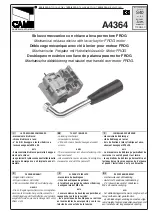
Page 10
Using the Rotary Tool
The first step in learning to use the Rotary Tool is to
get the “feel” of it. Hold it in your hand and feel its
weight and balance. Feel the taper of the housing. This
taper permits the Rotary Tool to be grasped much like
a pen or pencil.
When you turn on the tool for the first time, hold it
away from your face. Accessories can be damaged
during handling, and can fly apart as they come up to
speed. This is not common, but it does happen.
Practice on scrap materials first to see how the Rotary
Tool cuts. Keep in mind that the work is done by the
speed of the tool and by the accessory in the collet.
You should not lean on or push the tool into the work.
Instead, lower the spinning accessory lightly to the
work and allow it to touch the point at which you want
cutting (or sanding or etching, etc.) to begin. Con-
centrate on guiding the tool over the work using very
little pressure from your hand. Allow the accessory to
do the work.
Usually, it is best to make a series of passes with the
tool rather than attempt to do all the work in one pass.
To make a cut, for example, pass the tool back and
forth over the work, much as you would a small paint
brush. Cut a little material on each pass until you reach
the desired depth. For most work, the gentle touch is
best. With it, you have the best control, are less likely
to make errors, and will get the most efficient work out
of the accessory.
For best control in close work, grip the Rotary Tool
like a pencil between your thumb and forefinger.
The “handgrip” method of holding the tool is used
for operations such as grinding a flat surface or
using cutoff wheels.
aa
WARNING
Wear Eye Protection
Whenever you hold the tool, be
careful not to cover the air vents
with your hand. This blocks the air flow and causes
the motor to overheat.
CAUTION
!
Questions or Problems ? Call 03-5415317
or check our website at www.Dremel.com
DM 2610934164 05-06 10/6/06 8:41 AM Page 10









































